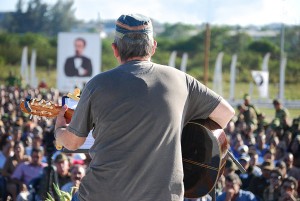Cuba Finally Quantifies Its Prisoners

HAVANA TIMES — The number of prisoners in Cuban jails is 57,337, a figure just revealed by the official Granma newspaper after decades of silence on the issue. This total places Cuba in a better position than the US, a country with more than 700 prisoners per 100,000 inhabitants.
For many years, figures supplied internationally by the Cuban opposition were taken as good approximations. They estimated the number of prisoners as double this newly disclosed total, thereby ensuring that for its size Cuba held the most inmates with the world.
The official newspaper explains that Cuban prisons also have a rehabilitation system that allows nearly half of those prisoners to serve their time in facilities that are open, while thousands are studying and some 23,000 are learning trades through work.
Moreover, while the number of people in prison for political and common crimes is declining, the figures for officials arrested for corruption is growing. Some sources speak of hundreds of such detainees, though silence was maintained on this issue.
Swedish furniture
This new information breaks a long period of silence on the part of the Cuban government regarding prisons, whose facilities are virtually closed to the press. Ironically, it was the dissent movement that had a monopoly on that information up until now.

The opposition Human Rights Commission, headed by Elizardo Sanchez, had estimated the number of inmates to be about 100,000, while other dissident sources alleged conditions marked by a lack of sufficient food and medicine, and forced labor.
This official information was disclosed following an intense campaign from the Cuban exile community charging the Swedish company IKEA of having attempted to have furniture assembled in Cuban prisons as part of an agreement with East German authorities.
Regarding this accusation, Granma newspaper acknowledged that 23,113 prisoners work, but it argues that their participation is voluntary, paid and includes social security benefits. “They receive wages at the rates established in the country for all other workers,” the article reads.
Reintegration programs
The newspaper claims that almost all prisoners benefit from reintegration programs and policies. “A total of 27,095 inmates receive schooling at all levels of education, and 24,531 are integrated into skills training programs on site or in specialized courses.”
Social reintegration policies have had an upturn since 2009 with the inclusion of cultural programs that feature art exhibitions and musical tours, such as the one made to various prisons by singer/song-writer Silvio Rodriguez.

Meanwhile, the National Sports Institute (INDER) is promoting its Inter-prison Olympics, to which we were invited to the Latin American Stadium to watch the final baseball game between prisons in Santiago de Cuba and Havana.
According to official figures, during the last six months over 10,000 prisoners were released for various reasons, including 2,900 who left to mark the end of the year and 130 political prisoners released through an agreement with the Catholic Church.
When the pardon was announced in December 2012, it was also ensured that each end of the year consideration would be given to releasing a similar number of prisoners who have served parts of their sentences and do not pose a danger to society.
The main enemy
Meanwhile, the anti-corruption campaign sweeping the country has led to the arrests of figures in all spheres of society. Some sources put the number of these new prisoners at more than 400 prominent former officials, managers, etc.
According to one imprisoned official, if the conviction is for less than six years, the person found to be corrupt will work on a farm, where the regimen is lighter. But if their time exceeds 10 years, they have to serve their sentences in common prisons.
The government seems to have identified white-collar crime as its main enemy. The costs of social, economic and political corruption are enormous, much greater than what can be caused by common criminals or political dissidents.






Doing better than the NORTH
There are two things missing here: (1) that may be the figure today but what was the figure in the 60 and 70s when every family in the country had at least one male relative in jail? THOSE are the figures we want to know! And (2) those are the figures declared by the government. Since the regime has never been known to tell the truth about anything, there’s no reason to believe this to be the first time. If they declared 57k prisoners, the reality is that it’s probably double that.
Before castro era and even under Batista dictatorship Cuba solved its imprisonment needs with 6 jails …… castro regime needs more than 400……
Why would we believe castro statistics when it is proven those statistics are always “inaccurate”……. regime always said there was no political prisoners in Cuba but recently released more than 100 of such prisoners ……
Political prisoners recently released were charged for different “crimes”…..but it seems there was no crime in any case because you don’t release a convicted criminal until its condemn is not fulfilled……… that means those people were charged and condemned under false accusations and could not be kept in prison without a huge political loss for regime and international discredit.
The main cause of so big need of jails in Cuba is the law code created by regime in order to keep Cubans as second class citizens only good to obey; a law code that forbids almost anything.